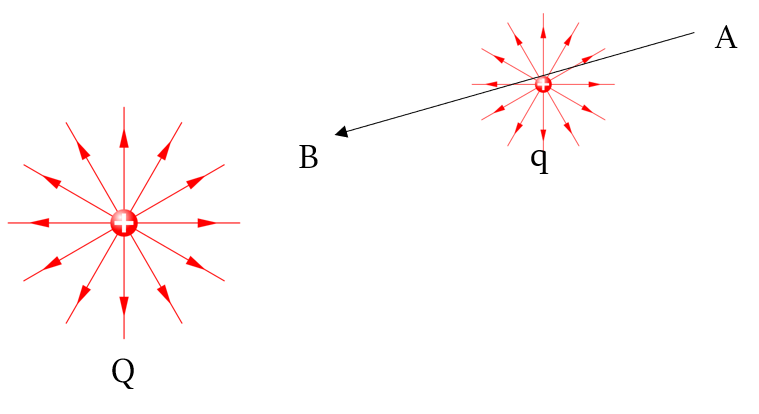Electric field and Coulomb’s law
In this article, we are going to learn about Electric field and Coulomb’s law.
 Table of Contents
Table of Contents- Coulomb’s law
- Electric field
- Electrostatic potential
Coulomb’s law
Coulomb discovered that the mathematical relation of the force between two point charges varies with their magnitudes and the distance between them. This has been termed as Coulomb’s law.
As per Coulomb’s law, the force between two point charges is:
- directly proportional to the product of the magnitude of the two charges, and
- inversely proportional to the square of the distance between the charges.
This force acts along the line joining the two charges.
Magnitude of the force (F) between two point charges, F = k \(\frac{|q_1 \hspace{1ex} q_2 |}{r^2}\)
Where, \(q_1\), \(q_2\) are two point charges separated by a distance r in vacuum.
 Note
NoteApart from this law, Coulomb also found the inverse square law of force between unlike and like magnetic poles.
But what is the reason behind such a force existing between two electric charges? – The answer is Electric field.
Electric field
A charge produces an electric field everywhere in the surrounding. When another charge is brought in this field, it acts on it and produces a force.
Definition of Electric field:
The electric field due to a charge at a point in space, is the force that a unit positive charge would experience if placed at that point.
Characteristics of Electric field:
- Electric field is a vector field, since force is a vector quantity.
- An electric field line is an imaginary line. It may also be an imaginary curve, so that its tangent at any point is in the direction of the electric field vector at that point.
- Electric field lines always begin on a positive charge and end on a negative charge. They do not start or stop in mid-space.
- Two electric field lines can never intersect.
- We get an idea about the intensity of electric field at any point by observing the relative closeness of the electric field lines at that point.
Formula of Electric field:
Electric field due to a point charge q at a distance r, E = \(\frac{1}{4π ε_0}\) . \(\frac{q}{r^2}\)
Therefore, electric field intensity is directly proportional to the magnitude of the charge, and inversely proportional to the square of the distance r from the point charge.
\(ε_0\) is the Permeability constant, which is the permeability of free space or vacuum permittivity.
Electrostatic potential
Electrical potential at a point (in the presence of field due to any charge configuration) is the work done by the external force (equal and opposite to the electric force) in bringing a unit positive charge from infinity to that point.
So, Electrical potential = \(\frac{Work \hspace{1ex} done}{Charge}\)
Electrical difference is a scalar quantity. Its SI unit is volt (V). We measure Electrical potential by means of a voltmeter.
Well, this is the technical definition of Electrostatic potential. It may have bamboozled you. So, let’s try to understand it in more detail.
We know that in case of conservative forces the sum of kinetic and potential energy is conserved. Spring force, Gravitational force, as well as Coulomb force between two (stationary) charges are examples of conservative forces.
When an external force does work in taking a body from a point to another against a conservative force, that work gets stored as potential energy of the body. When the external force is removed, the body moves, gaining kinetic energy and losing an equal amount of potential energy.
 Gravitational potential energy Vs. Electrostatic potential energy
Gravitational potential energy Vs. Electrostatic potential energyIn case of both Gravitational law and Coulomb’s law, the force is inversely proportional to the square of the distance. Also, the masses in the gravitational law are replaced by charges in Coulomb’s law. Though the main difference between these two is the different proportionality constants.
Thus, like the gravitational potential energy of a mass in a gravitational field, we can define electrostatic potential energy of a charge in an electrostatic field.
Consider the presence of an electrostatic field E due to some positive charge +Q. Now, if we want to bring another positive charge +q closer to it (say from point A to point B), we will have to apply an external force to counter the repulsive electric force working on it due to the charge +Q.

Here, work done by the external force is the negative of the work done by the electric force, and gets fully stored in the form of potential energy of the charge +q.
We divide the work by the amount of charge q, so that the resulting quantity is independent of q. Thus, we get the concept of electrostatic potential. So, Potential difference (\(V_B - V_A\)) between two points B and A is the work done in bringing a unit charge from point A to Point B.
If the external force is removed on reaching B, the repulsive electric force will take the charge away from +Q. Now, the stored potential energy in charge +q will start converting into kinetic energy (sum of the kinetic and potential energies will remain conserved).
Potential Difference
Electrostatic potential may vary from one point in space to another. The difference between the electrostatic potentials at two points is the Potential Difference between those two points.
Potential difference decides the direction of flow of charge between two points in an electric field.
- Positive charge always moves from higher potential towards lower potential.
- Negative charge always moves from lower potential towards higher potential.
The value of electric potential at any point on the earth’s surface is assumed to be zero. So, earth is considered the reference level in the measurement of electric potential.
